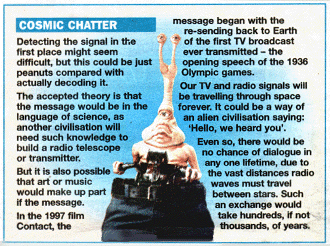Take me to your reader
Scott Snowdon
The discovery of an alien intelligence
on another planet is likely to be the most significant event to ever happen
to the human race, changing forever the way we see the Earth, our universe
and ourselves. Recent news that a radio signal, detected by the giant telescope
in Arecibo, Puerto Rico, could be a message from an alien civilisation stoked
the fires of extraterrestrial debate almost to melting point.
The signal was believed to have originated 3l mllion years ago and travelled
300 trilliion km before reaching Earth. But possibly the most signilicant
element of this riddle is that the frequency of the message is about 1420Mhz:
one of the main frequencies at which hydrogen, the common element in the
universe, readily absorbs and emits energy.
While this could he a coincidence, it is widely believed the common language
of science would be used to communicate a message through the cosmos: the
atomic numher of hydrogen, for example, has exactly the same value wherever
you are in the universe. However, the scientific community has agreed SHGbo2+14a,
as the signal is known, was not a message from an alien race. It believes
is was probably nothing more than a glitch or a distorted signal emitted
by a pulsar. Despite this setback, the Search For Extraterrestrial Intelligence
(SETI) research programme has recently had a major boost.
Microsoft co-founder Paul Allen has committed £6.3million to enable
construction of a vast array of radio telescopes - a forest of 350 radio
dishes, each one six metres across, all working synchronously. This project,
originally called the 1-Hectare Telescope, has heen renamed the Allen Telescope
Array (ATA) after Allen committed another £7.4million to ensure its
completion. However, the money isn't entirely free - it can only he accessed
after the SETI Institute and the University of California at Berkeley have
raised an additional £8.7mlllion. Furthering humanity doesn't come cheap.
COUNTDOWN TO CONTACT |
| 1960:
Frank Drake begins Project Ozma the first
scientific search for alien signals. |
 |
1979:
Senior SETI scientist Carl Sagan and others found
the Planetary Society using private money they fund SETI projects that are
denied government funding.
1982:
Senator William Proxmire threatens Nasa's
still-infant SETI effort with cancellation. Carl Sagan convinces him of its
worth, enabling the technology to be developed.
1993:
Senator Richard Bryan gets Congress to axe Nasa's SETI work, arguing that
$33million has been spent with no results.
1995:
The SETI Institute takes possession of most
of Nasa's. equipment and Project Phoenix is born, continuing the search at
installations around the world.
1999:
The SETI@home software is released and attracts millions of users. By downloading
SETI data over the Internet, their dormant PCs help analyse signals, much
to IT managers' annoyance.
|
|
2004: Construction of the Allen
Telescope Array begins,allowing more of the sky to be scanned than ever
before.
2035?:
A signal of undeniably extraterrestrial origin is detected and shown to contain
many layers of data. Humanity enters a new age as the process of decoding
it begins.... |
Leo Blitz, director of the Hat Creek
Radio Observatory where the ATA will he based, says fundraising has already
started and has been partly successful -'We have raised some of the money
that will allow us to build somewhere hetween 200 and 250 radio dishes,'
he explains. 'Additional fundraising will then bring the total to 350 dishes.'
Until now, the search for ET has suffered a nuinher of unfortunate setbacks,
mostly due to funding cuts. In 1993, US Senator Richard Bryan persuaded Congress
to axe Nasa's SETI work, arguing that $60million (£33million) had already
heen spent with no success. So, the SETI Institute took
possession of most of Nasa's SETI equipment and began Project Phoenix
- the current search for alien intelligence.'
Time allocated to SETI on existing telescopes, such as Arecibo, has been
limited to about 5 per cent. Scientists have heen scrounging time on dishes
all over the world as they lacked their own dedicated radio telescopes.
With the ATA, this will change as the new array will operate 24/7, scanning
more of the sky than has ever been possible before.
In July last year, a team of scientists at the Australian National University
calculated that the number of stars visible from Earth is about ten times
as many as grains of sand on all of its beaches and deserts (or seven followed
by 22 zeros). And that's just the ones we can see.
It is very likely that each of these stars has a group of orbiting planets,
similar to our solar system. That's a lot of planets. If none of the planets
orbiting the stars has life, it does indeed seem like an awful waste of space.
|

|
 |
-
ET DROPS IN: ET has arrived on Earth
in the form of red raindrops from outer space, say scientists. The specks
fell in India four years ago and researchers from Mahatma Gandhi University
ran tests to see if the microbes were from an alternate life form. They say
the microbes, which resemble red blood cells, may have come from a meteor
acting as a vehicle for spreading life, But some scientists are sceptical,
although the results were in respected joumal Astrophysics and Space
Science.
-
NEW BLACK: Stargazers are zeroing in on a new kind of
black hole. Researchers using a special X-ray telescope have found a giant
star orbiting a medium-sized black hole. They believe it could prove there
is a new class of black hole with a mass 100 to 10,000 times greater than
the Sun. The new holes would be larger than black holes
formed when a star collapses, but smaller than black holes in the centres
of galaxies, US researchers said.
-
PEST KILLER:
Ants
use the same techniques as humans to keep their gardens free of pests a study
shows.They develop a bactena to destroy parasites that eat their food. Attine
ants grow fung1 in large gardens
to feed their colonies. But parastic fungi also have a taste for their food.To
keep the pests at bay the ants carry antibiotic producing bacteria on their
bodies. When they find a pest
they rub the bactena on it, killing it instantly ,US researchers said.
-
BEAM ME UP:
Anti
-gravity machines that could make being beamed into space a
reality are more than just a pipedream. Scientists say a machine using
an intense magnetic field could overcome gravity and propel a spacecraft
to Mars in three hours. By increasing the magnetic field the craft might
then slip into another dimension where travel would be faster than the speed
of light. 'A working engine could be tested in five years,' said US scientist
Roger Lenard.
Do you have a story for MiniCosm? E-mail us at
cosm@ukmetro.co.uk
|
A leap into hyperspace
Fancy a trip to Mars but don't want to spend six months or more holed up
in a rocket? Soon you may be able to leave Earth at lunch time and reach
the red Planet in time for dinner, thanks to an astonishing new type of engine
which apparently would propel a craft through another dimension at enormous
speeds. There's just one catch: the machine relies on an obscure and largely
unheard of kind of physics. If the experiment gets the go-ahead and works,
it could reveal new interactions between the fundamental forces of nature
that would change the future of space travel...more
[New Scientist] |
|
